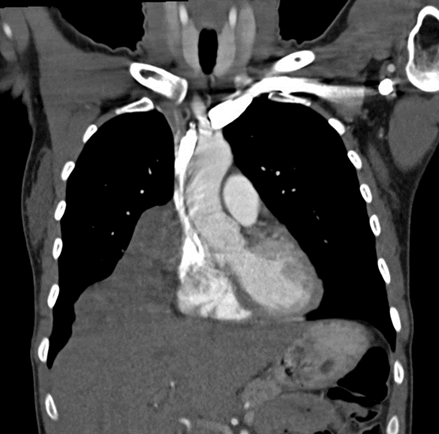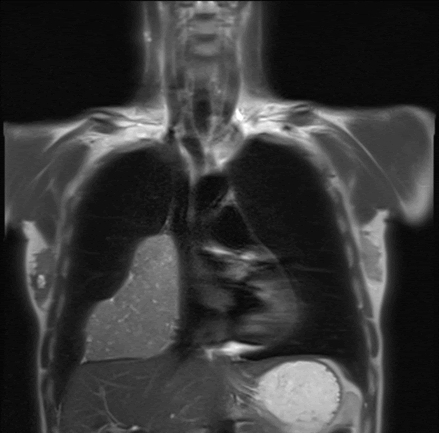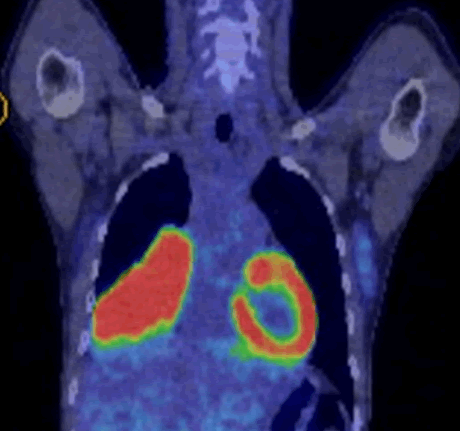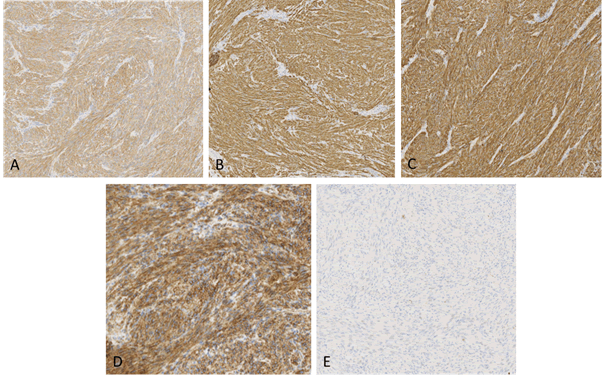Case Report - (2022) Volume 6, Issue 2
Received: 02-Mar-2022, Manuscript No. iprjo-22-12546; Editor assigned: 02-Mar-2022, Pre QC No. iprjo-22-12546 (PQ); Reviewed: 18-Mar-2022, QC No. iprjo-22-12546; Revised: 23-Mar-2022, Manuscript No. iprjo-22-12546 (R); Published: 30-Mar-2022, DOI: 10.36648 /iprjo.6.2.7
Background: Programmed the presence of leiomyoma in the anterior mediastinum is uncommun and less than 20 cases were described in the literature. Herein we report a 44 year old woman with an asymptomatic anterior mediastinal mass who underwent complete surgical tumor resection.
Methods: Imaging techniques, anatomopathological analysis and immunohistochemical stains were performed to find the diagnosis.
Results: The proposed pathological diagnosis is primary mediastinal leiomyoma.
Conclusion: Primary mediastinal leiomyoma is a rare benign tumor. It develops from smooth muscle fibers of large vessels or esophagus. Total surgical resection is the treatment of choice.
Mediastinum; Leiomyoma; Anterior mass
Leiomyomas are benign smooth muscle tumors that usually occur in the urogenital or digestive tract. Their presence in the anterior mediastinum is uncommon. Less than 20 cases were described in the literature. These tumors are slow growing and do not have many symptoms. They are often found incidentally on imaging exams, and can be large at the moment of the diagnosis. In this case report, we describe a woman with an asymptomatic primary mediastinal leiomyoma, who underwent complete surgical tumor resection.
The patient is a 44 year old woman who was transferred to our hospital for surgery due to a mediastinal mass lateralized to the right. She had no relevant medical history and was an ex-smoker. She presented no significant symptoms except for a slight oppression during her meditation sessions. During a medical checkup for an umbilical hernia, the physician incidentally found a mediastinal mass lateralized to the right. Physical examination, pulmonary function tests and heart check-up were normal. Laboratory tests were normal, including tumor markers alpha-fetoprotein and B-HCG. Contrast-enhanced CT of the chest was performed and revealed a right anterior para-cardiac mediastinal mass measuring 8.7 x 8 x 7.2 cm (antero-posterior, cranio-caudal, latero-lateral). The mass was well-defined and homogenous (45 HU), enhancing after contrast in arterial phase at 55 HU-60 HU and in venous phase at 90 HU-100 HU. No mediastinal adenopathy was observed (Figure 1). An MRI was performed to evaluate the different surgical planes of cleavage. The mass was encapsulated with regular outlines. It was in contact with the diaphragm, the bottom of the right atrium and the right edge of the superior vena cava (Figure 2). There were no arguments for an invasion of the great vessels of the thorax or cardiac cavities. The mass was intensely hypermetabolic on PET-CT (Figure 3).

Figure 1: Contrast-enhanced computed tomographic (CT) views of the chest. Large right anteroinferior paracardiac mediastinal mass, well delimited, homogeneous (45HU) non-invasive. First hypothesis was a thymoma of the right pleuropericardial angle

Figure 2: Magnetic resonance imaging (MRI): Large right lower paramediastinal mass, encapsulated, without direct or indirect evidence of invasion of adjacent structures.

Figure 3: PET-CT: Intensely hypermetabolic right anterobasal paracardial mass.
Clinical and radiographic differential diagnosis at this point was thymoma, thymic carcinoma, lymphoma, sarcoma or germ cell tumor. The mass was well-encapsulated and a biopsy would be deleterious with a risk of swarming in the right pleural cavity. The decision of total surgical resection was decided.
The patient underwent a mini right anterolateral thoracoto my. At the opening of the pleural cavity, the surgeon visualized a voluminous richly vascularized mass, with no infiltrative character. The tumor was resected without complications. The patient had a complete recovery and was discharged on the seventh postoperative day.
Gross pathologic examination of the mass revealed a homogenous white mass with a firm consistency. There were no areas of necrosis or hemorrhage. It was encapsulated, and the capsule was thin and fibrous. Histologically, the lesion consisted of monomorphic spindle cells with blunt ended nuclei, arranged in interlacing fascicles. The nuclei did not show any nuclear atypia or mitosis (Figure 4). Immunohistochemical stains demonstrated that the tumor cells are strongly positive for smooth muscle actin (SMA), desmin and caldesmon. They were negative for CKAE1/E3, S100, STAT6, DOG1 and Beta catenin (Figure 5). The tumor was diagnosed as primary mediastinal leiomyoma.

Figure 4: Microscopic examination (Hematoxylin & Eosin, 10x (A) and 20x (B)). Monomorphic spindle cells with blunt-ended nuclei, arranged in interlacing fascicles.

Figure 5: Immunohistochemical stainings of the tumor (10x).Strongly positive for Smooth Muscle Actine SMA (A), desmin (B) and caldesmone (C). Negative for Beta catenin (D). Negative for CKAE1E3, S100, STAT6 and DOG1 (E).
In the literature, only less than 20 cases of primary mediastinal leiomyomas have been described. In the different cases described, primary mediastinal leiomyomas are frequent in adult women. However, Li and al. reported a case of mediastinal leiomyoma in a 3 year old girl. These are rare tumors which develop from the smooth muscles of large vessels or esophagus. The MRI of our case shows no clear origin of the tumor. Mediastinal leiomyomas are slow growing with little symptoms and they are usually large at the time of discovery. Even if the patient is asymptomatic, total surgical resection is the treatment of choice due to the continuous growth of the tumor giving mass effects. Baldo and al. reported a case with angiographic study and embolization of the feeding vessels. This method could be helpful when faced with a vascularized tumor mass, in order to have better control of the bleeding during surgery. It would be more efficient when leiomyoma comes from large vessels [1-8]. The final diagnosis of primary mediastinal leiomyoma is done by histologic examination. Leiomyoma is a benign tumor consisting of intersecting fascicles of monotonous spindle cells with “cigar shaped” nuclei. Nucleocytoplasmic atypia is mild or absent and mitoses are rare (in general <5/10 high power fields). Specific immunohistochemical stains smooth muscle actin(SMA), caldesmon, desmin are a diagnosis sign for leiomyomas.
Prognosis for leiomyoma is excellent with no recurrence. Nevertheless the diagnosis of leiomyosarcoma needs to be excluded. Xue and al. reported a case of anterior mediastinal leiomyosarcoma. Microscopically the tumor cells are irregular. Mitotic index is typically high (>10 mitoses/10 high power fields), tumor cell necrosis and cellular atypia are often seen [3,9].
In conclusion, primary mediastinal leiomyoma is a rare benign tumor. It develops from smooth muscle fibers of large vessels or esophagus. Total surgical resection is the treatment of choice.
Not applicable.
The case report protocol was approved by the institutional ethics and research review boards at Erasme Hospital. Patients signed a written informed consent upon admission to the hospital. Patients chose at admission whether to opt in or to opt out of providing consent, which affirms that physicians have the right to use patient’s surplus biological material for research. Consent has been established by the local ethics committee (ethics committee Erasme-ULB) and is in accordance with Belgian and International law (Helsinki declaration).
Not applicable
Ngoc My Lam declares that she has no competing interests. Matteo Cappello declares that he has no competing interests. Annick Foucart declares that she has no competing interests. Myriam Remmelink declares that she has no competing interests.
The authors have not declared a specific grant for this research from any funding agency in the public, commercial or not for profit sectors.
NML and MR performed the histological examination of the mediastinal mass. NML wrote the main manuscript text and prepared all the figures. MR was a major contributor in writing the manuscript. All authors read and approved the final manuscript.
Not applicable.
Citation: Ngoc My Lam, Matteo Cappello, Annick Foucart, Myriam Remmelink (2022) Case Report: Primary Mediastinal Leiomyoma. Res J Onco Vol.6:2
Copyright: ©Ngoc ML, et al. This is an open-access article distributed under the terms of the Creative Commons Attribution License, which permits unrestricted use, distribution, and reproduction in any medium, provided the original author and source are credited.